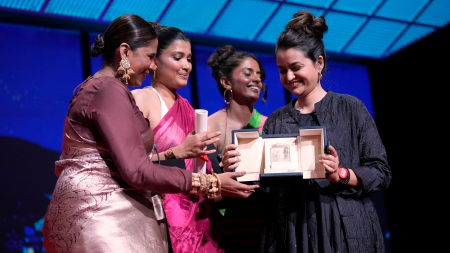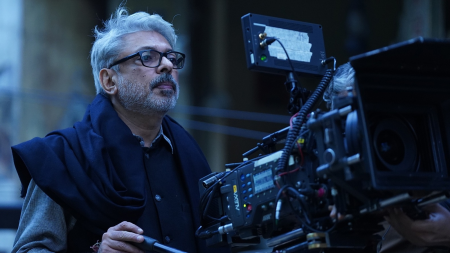“Thank you very much Cannes Film Festival for having our film here. Please don’t wait for another 30 years to have another Indian film,” said Payal Kapadia as she picked up the prestigious Grand Prix for her debut feature, All We Imagine As Light, at the 77th Cannes Film Festival. Kapadia had entered the much-feted Competition Section thirty years after an Indian film made the cut — Shaji N Karun’s Swaham was in the Competition line-up in 1994.
There has been a long drought since, and Kapadia’s film has broken through, gloriously.

This Cannes has already begun well for India, with a Best Actress win for Anasuya Sengupta for Bulgarian director Konstantin Bojanov’s dark tale of female exploitation Shameless (Un Certain Regard section), in which she plays a sex worker on the run. In the La Cinef category, Chidananda S Naik’s Sunflowers Were The First To Know and UK-based Mansi Maheshwari’s Bunnyhood got the first and third prizes respectively. Cinematographer and director Santhosh Sivan also received the prestigious Pierre Angénieux ExcelLens in Cinematography honour at Cannes, the first Asian to win this prestigious award. Kapadia’s coveted trophy, the festival’s second-highest award, is a perfect cherry on top. The Palme d’Or went to American filmmaker Sean Baker for his film Anora.
Kapadia’s film, an elegiac exploration of urban loneliness and connection, follows Kani Kusruti and Divya Prabha as two Malayali nurses working in Mumbai, experiencing the very specific kind-cruel ways of big city life. That striving, much more of a challenge in the mahanagri that is Mumbai, comes with the anonymity and safety that women savour.
It is present in every frame of this film, with its interplay of light and dark, as it probes the crevices of suppressed desire in Prabha and Anu. The latter is in a clandestine relationship with the Muslim Shiz, played by Hridhu Haroon, and has become an item of gossip amongst the nursing staff at their hospital; the older Prabha is married, but has to deal with the inexplicable prolonged absence of her husband.
Disapproving of Anu’s free ways, Prabha spends time with Parvaty, played by Chhaya Kadam, a widow who has no papers to prove that she has lived in her modest home, and is on the verge of being thrown out: migration and dislocation in never-ending waves is also a Mumbai reality, which the film reflects. All three actors joined Kapadia on stage.
“This film is about friendship between three women and oftentimes women are pitted against each other. This is the way society is designed and it is very unfortunate. But for me friendship is a very important relationship because it can lead to greater solidarity, inclusivity and empathy towards each other,” said Kapadia in her acceptance speech.
A conversation a day before the win with Kapadia and her partner Ranabir Das, the cinematographer of the film, flows easily.
“As I’m growing older, I’m seeing the bonds that we have created with our friends, and how they are family,” says Kapadia. “This film is also about friendship and those indelible bonds.”
It has its roots in a couple of medical situations that she had to deal with a few years back, with both her grandmother and father needing support at home. “I became friends with the Malayali nurses who would come in to help, and started seeing their lives in the hospital and outside as a microcosm for a lot of larger things.”
The film, which was scheduled almost at the end of the 11-day festival, came as a bracing lift in the strictly average Competition section this year. Kapadia, who is a familiar face at Cannes (her short film Afternoon Clouds, and her documentary, A Night Of Knowing Nothing have both been showcased here), knows exactly how much of a thrill it was to have her feature premiere at the Grand Salle Lumiere: the infectious joy of her cast letting themselves go on the red carpet, and basking in the eight-minute standing ovation post-screening, was palpable.
It is also a film which melds the personal and political, continuing with Kapadia’s thematic preoccupations. “It was very important for us to take note of those people who do not have documentation (‘kaagaz’) to prove their identity,” she says. Parvaty represents those lost souls who are forced to leave their homes. In the film, the return to her roots in Ratnagiri is seen not as a loss but a gain, when all three women, and the man, find themselves in an idyllic spot, far away from the claustrophobia of the city, breaking out into the light.
Where does the name of the film come from? It’s the name of a painting made by Kapadia’s mother, the artist Nalini Malani. “When I saw it, I was struck by how much of it reflected my work, and I asked her for the name. She generously agreed,” says Kapadia.
And now that name is out in the world, glowing.
Disclaimer: The copyright of this article belongs to the original author. Reposting this article is solely for the purpose of information dissemination and does not constitute any investment advice. If there is any infringement, please contact us immediately. We will make corrections or deletions as necessary. Thank you.







